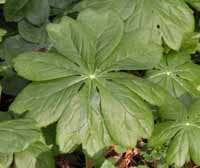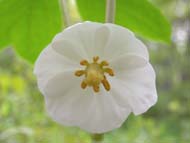 |
| Mayapple Plant |
 |
| Flower bud forming ... |
 |
| Mayapple Flower |
Podophyllum peltatum
Warning
Fruit is edible but other parts of this plant are poisonous!
Common Names
Common mayapple, devil's apple, duck's foot, ground lemon,
hog apple, Indian apple, mandrake, mayapple, podophyllum,
racoonberry, umbrella plant, vegetable calomel, vegetable
mercury, wild jalap, wild lemon, wild mandrake, yellowberry.
Description
An erect perennial that grows to about 1 to 11/2 feet in height.
Two umbrella-like, palmately lobed leaves grow at the top of each
plant, rarely 3. The plant produces a white flower in fork of
leaves, and ovate yellow fruit.
Flowering Period
March to May
Habitat
Deciduous forest in mountain areas, rich woods, thickets, and
pastures; prefers shade.
Harvest
Rootstock in fall and sometimes in spring before leaves appear
Edible Uses:
The fruit may be eaten raw after it is ripened by frost, but
not everyone enjoys the flavor. Ripened fruit is cooked into jam
or jelly.
Uses
Improper use of this plant could be very dangerous. The roots and
rhizomes are used as a purgative. A resin from the plant, called
padophyllin, has been used to treat venereal warts. The resin is
extremely allergenic; it exhibits anti-tumor activity. In Appalacia,
a tea of bark and roots is used to treat constipation.
Externally, mayapple is used as a treatment for warts and skin eruptions. Internally, a very small amount of root may be used as a cathartic (Laxative), a worm expellant, for jaundice, constipation, hepatitis, fever and syphilis.